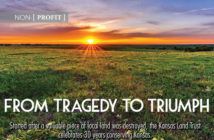Haskell and KU both work hard toward a more sustainable environment for students, faculty and staff.
| 2020 Q1 | story by Joshua Falleaf | photos by Steven Hertzog

University of Kansas, Haskell Indian Nations University
As thought leaders in the Lawrence community, Haskell Indian Nations University and the University of Kansas (KU) are taking strides to build more sustainable campuses and communities. With faculty, staff and students at each institution interested in sustainable practices, bringing energy and coalitions together can be a challenge for both. Despite this similarity of purpose, the practical application and implementation of sustainability differs significantly in terms of scale.
With 28,500 students and 400 various degree and certificate programs, KU consumes massive amounts of energy to keep its residence and academic halls functioning for students, faculty and staff. Add to that the energy necessary to run state-of-the-art research facilities, and one can see the challenges for Jeff Severin, director of the Center for Sustainability, and its three-person staff.
Haskell, on the other hand, serves just under 1,000 students and offers four bachelor’s degree programs along with a number of associate and certificate programs. A residential university, Haskell houses students from across Indian Country, less than 10% living off campus. Yet, despite its small size, Bill Welton, adjunct instructor and project director of several grants, and a few other faculty, staff and students committed to creating a more sustainable campus are trying to create a more sustainable infrastructure to maintain the efforts.
A teaching university serving a 100-percent indigenous student body, many of Welton’s efforts are aligned with the academic goals of the university, in particular the environmental science program. His office was created to “manage initiatives that provided experiential learning opportunities for students in sustainability,” according to its previous USDA-NIFA (National Institute of Food and Agriculture) equity grant proposal. For the most recent cycle of the grant, the emphasis is on “developing student leaders who will drive sustainability programs forward” in an effort to create a more significant presence and stability for sustainable initiatives.
Under the leadership of Daniel Wildcat, Ph.D., the Tribal ecoAmbassadors program brings classroom teaching into real-world application. Two primary initiatives, food waste reduction and landscaping/habitat restoration, were supported by project-based learning activities in classes from the environmental science, indigenous and American Indian studies, and business programs.
 For instance, some Tribal ecoAmbassadors are concurrently enrolled in AIS 301, Native and Western Views of Nature. In the class, they learn that the efforts of ecoAmbassadors reflect many North American indigenous worldviews, philosophies and cultural practices as they contrast with western approaches that now have made sustainable practices more necessary than ever.
For instance, some Tribal ecoAmbassadors are concurrently enrolled in AIS 301, Native and Western Views of Nature. In the class, they learn that the efforts of ecoAmbassadors reflect many North American indigenous worldviews, philosophies and cultural practices as they contrast with western approaches that now have made sustainable practices more necessary than ever.
Former Tribal ecoAmbassador Shane Lynch says, “It was nice that it was driven by students,” adding that “more publicity” and “more accessibility” are important to keep the momentum going.
An emphasis on getting the word out about sustainability is just as important at KU, despite the significant difference in scale. “One of the things we’re working on,” Severin explains, “is how do we do a better job of telling the story of sustainability at KU, because a lot of folks don’t even know that we exist?” Previous chancellor Bernadette Gray-Little believed in the goals of KU’s Center for Sustainability, commissioning a 75-page plan called “Building Sustainable Traditions: University of Kansas Campus Sustainability Plan” (2016) and stating, “We must elevate the expectations we have for ourselves as a community—finding ways to maximize the benefits of the work we do at KU while minimizing any financial, environmental and societal costs.”
Severin, who began the position as director of the Center in 2007, explains: “When we talk about sustainability here, we’re talking about it in terms of how do we protect our natural ecosystems, promote economic prosperity and treat all people with equity and respect?”
One of many signature achievements of the partnerships across KU’s campus is the Prairie Acre. After being unattended for some years, this “unplowed, native prairie remnant” caught the attention of students, and in 2014, a senior student in professor Kelly Kindscher’s environmental studies capstone course took it up as a project. The process of restoration has been ongoing ever since through the meaningful collaboration of the KU Center for Sustainability, the Environmental Studies Program and the Kansas Biological Survey.
“Classes like that have always been a part of the work that we do through our Center,” Severin says. “They will often have a group of students, if not multiple groups of students, looking at some campus issue. And, historically, we’ve tried to integrate some of that into the work that we do.”
At Haskell, Welton and his team of sustainable partners are also focused on the people involved, particularly students and the tribal nations in the region. Working with Kansas State University, the Prairie Band Potawatomi Nation and the Kansas Kickapoo Tribe on their gardening initiatives, the Douglas County Master Gardener program is focused on “what plants we can encourage those tribal communities to grow” that do not require excess quantities of water, Welton says. “Both are in food deserts, typical for reservations,” he adds, so the research efforts students perform at the Haskell Research Garden is very helpful in creating a more sustainable local food system to support the citizens of those two nations.
In alignment with Haskell’s mission, a larger aim is to “build the leadership capacity of our students … to address the needs of indigenous communities.” Through partnerships with area tribal nations and the tribal students engaged, the passion and expertise in sustainable practices, while different for each university, clearly translate into students’ impact on families and communities after graduation.
In November 2018, KU partnered with Westar Energy to ensure the majority of its energy comes from wind, a renewable source that is bolstered by the construction of Soldier Creek Wind Farm, in Nemaha County. This construction is due to be completed by the end of 2020.
“[KU] will be purchasing the equivalent of our energy consumption in wind power,” Severin says. “That’s a pretty big step when thinking about our campus and the greenhouse gases that we’re responsible for.” He adds, “That doesn’t mean that we shouldn’t also continue to decrease the amount of energy that we’re using.”
There are two factors impacting these two local educational institutions: investment of the heart and planning. Transitioning between student groups and changing administrations over the years makes momentum difficult to build. “One semester there will be a lot of interest depending on the students,” Welton says. “Then, the next semester, you don’t hear anything.”
Actionable items with determined outcomes, as well as the resources to fulfill them, are critical for each university. In the meantime, students, faculty and staff do their best to communicate the critical need to shift paradigms to create a more sustainable future for both universities.




